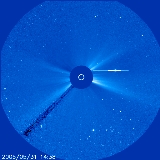
Cayrel's Star
Encyclopedia
BPS CS31082-0001, named Cayrel's Star, is an old Population II star
located in a distance of 4 kpc in the Galactic Halo
. It belongs to the class of ultra-metal-poor stars (Metallicity
[Fe/H]=-2.9), especially the very rare subclass of neutron-capture enhanced stars. It was discovered by Tim C. Beers and collaborators with the Curtis Schmidt telescope at the Cerro Tololo Inter-American Observatory
in Chile
and analyzed by Roger Cayrel
and collaborators. They used the Very Large Telescope
(VLT
) at the European Southern Observatory
in Paranal, Chile
for high-resolution optical spectroscopy
to determine elemental abundances. The Thorium
-232 to Uranium
-238 ratio was used to determine the age. It is estimated to be about 12.5 billion years old, making it one of the oldest known.
Compared to other ultra-metal-poor, r-process
enriched stars (as CS22892-052, BD +17° 3248, HE 1523-0901
) CS31082-001 has higher abundances of the actinide
s (Th, U), but a surprisingly low Pb abundance.
Star
A star is a massive, luminous sphere of plasma held together by gravity. At the end of its lifetime, a star can also contain a proportion of degenerate matter. The nearest star to Earth is the Sun, which is the source of most of the energy on Earth...
located in a distance of 4 kpc in the Galactic Halo
Galactic halo
The term galactic halo is used to denote an extended, roughly spherical component of a galaxy, which extends beyond the main, visible component. It can refer to any of several distinct components which share these properties:* the galactic spheroid...
. It belongs to the class of ultra-metal-poor stars (Metallicity
Metallicity
In astronomy and physical cosmology, the metallicity of an object is the proportion of its matter made up of chemical elements other than hydrogen and helium...
[Fe/H]=-2.9), especially the very rare subclass of neutron-capture enhanced stars. It was discovered by Tim C. Beers and collaborators with the Curtis Schmidt telescope at the Cerro Tololo Inter-American Observatory
Cerro Tololo Inter-American Observatory
The Cerro Tololo Inter-American Observatory is a complex of astronomical telescopes and instruments located at 30.169 S, 70.804 W, approximately 80 km to the East of La Serena, Chile at an altitude of 2200 metres. The complex is part of the National Optical Astronomy Observatory along with Kitt...
in Chile
Chile
Chile ,officially the Republic of Chile , is a country in South America occupying a long, narrow coastal strip between the Andes mountains to the east and the Pacific Ocean to the west. It borders Peru to the north, Bolivia to the northeast, Argentina to the east, and the Drake Passage in the far...
and analyzed by Roger Cayrel
Roger Cayrel
Roger Victor Emile Cayrel is a French astronomer. His main interests are stellar atmospheres, galactic chemical evolution and metal-poor stars....
and collaborators. They used the Very Large Telescope
Very Large Telescope
The Very Large Telescope is a telescope operated by the European Southern Observatory on Cerro Paranal in the Atacama Desert of northern Chile. The VLT consists of four individual telescopes, each with a primary mirror 8.2m across, which are generally used separately but can be used together to...
(VLT
VLT
VLT may stand for:* Very Large Telescope, a system of four large optical telescopes organized in an array formation, located in northern Chile...
) at the European Southern Observatory
European Southern Observatory
The European Southern Observatory is an intergovernmental research organisation for astronomy, supported by fifteen countries...
in Paranal, Chile
Chile
Chile ,officially the Republic of Chile , is a country in South America occupying a long, narrow coastal strip between the Andes mountains to the east and the Pacific Ocean to the west. It borders Peru to the north, Bolivia to the northeast, Argentina to the east, and the Drake Passage in the far...
for high-resolution optical spectroscopy
Astronomical spectroscopy
Astronomical spectroscopy is the technique of spectroscopy used in astronomy. The object of study is the spectrum of electromagnetic radiation, including visible light, which radiates from stars and other celestial objects...
to determine elemental abundances. The Thorium
Thorium
Thorium is a natural radioactive chemical element with the symbol Th and atomic number 90. It was discovered in 1828 and named after Thor, the Norse god of thunder....
-232 to Uranium
Uranium
Uranium is a silvery-white metallic chemical element in the actinide series of the periodic table, with atomic number 92. It is assigned the chemical symbol U. A uranium atom has 92 protons and 92 electrons, of which 6 are valence electrons...
-238 ratio was used to determine the age. It is estimated to be about 12.5 billion years old, making it one of the oldest known.
Compared to other ultra-metal-poor, r-process
R-process
The r-process is a nucleosynthesis process, likely occurring in core-collapse supernovae responsible for the creation of approximately half of the neutron-rich atomic nuclei that are heavier than iron. The process entails a succession of rapid neutron captures on seed nuclei, typically Ni-56,...
enriched stars (as CS22892-052, BD +17° 3248, HE 1523-0901
HE 1523-0901
HE 1523-0901 is the designation given to a red giant star located in the Milky Way galaxy approximately seven and a half light-millennia from Earth. It is thought to be a second generation Population II, or metal-poor, star . The star was found in the sample of bright metal-poor halo stars from the...
) CS31082-001 has higher abundances of the actinide
Actinide
The actinide or actinoid series encompasses the 15 metallic chemical elements with atomic numbers from 89 to 103, actinium through lawrencium.The actinide series derives its name from the group 3 element actinium...
s (Th, U), but a surprisingly low Pb abundance.
External links
- SIMBAD-Entry (SIMBADSIMBADSIMBAD is an astronomical database of objects beyond the Solar System...
) - R-Process Cosmo-Chronometers

